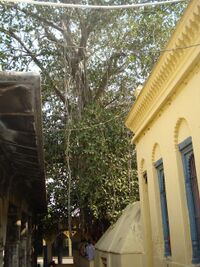Akshyavata
| Author:Laxman Burdak, IFS (R) |

Akshayavat (अक्षयवट) is a sacred fig tree mentioned in the Hindu mythology. It means the indestructible banyan tree. Author (Laxman Burdak) visited Gaya on 11.11.2010 and has provided content and images here.
Contents
Variants
Akshayavat Prayagraj
A tree in Prayagraj has been described as Akshayavat in the Prayag Mahatmya of the Matsya Purana.[1]
In The Encyclopaedia Asiatica (1976), Edward Balfour identifies a banyan tree mentioned in Ramayana with the tree at Prayag.[2] Rama, Lakshmana and Sita are said to have rested beneath this tree.[3]
The Chinese Buddhist pilgrim Xuanzang mentions a tree (a stump with few branches[4]) which was said to be the home of a man-eating demon. As part of a custom, some pilgrims would offer themselves at the nearby temple. Xuanzang mentions that the tree was surrounded with the human bones. Alexander Cunningham identified this tree with the Akshayavat at Prayag.[5] Rishabha (Jain tirthankar) is also said to have practised tapasya beneath the historical Akshayavat at Prayag.
Akshayavat Gaya
A tree at Gaya, Bihar[6][7] The Bodhi tree is said to be a manifestation of the Akashayavat at Prayag.[6]
Another tree at Varanasi is also worshipped as the Akshayavat.
Akshayavat at Other places
A tree at Kurukshetra, claimed to be the Akshay Vat.
According to Tibetan Buddhist tradition, Buddha is said to have planted a seed of the Prayag's Akshayavat next to Mount Kailash on a mountain known as the Palace of the Medicine Buddha.
अक्षयवट गया
विजयेन्द्र कुमार माथुर[8] ने लेख किया है ... कहा जाता है कि मूल बोधिद्रुम अथवा पीपलवृक्ष को गौड़ नरेश शशांक ने, जो महाराज हर्ष का समकालीन था (सातवीं शती ई.), अधिकांश में विनष्ट कर दिया था किंतु यह भी संभव है कि वर्तमान वृक्ष मूलवृक्ष का ही वंशज हो. इसी वृक्ष की एक शाखा अशोक की पुत्री संघमित्रा ने सिंहलदेश में ले जाकर अनुराधापुर में लगाई थी. यह वृक्ष वहां अभी तक स्थित बताया जाता है. इसी सिंहलदेशीय वृक्ष की एक शाखा वर्तमान सारनाथ के जीर्णोद्धार के समय कुछ वर्षों पूर्व वहां विरोपित की गई थी. यह भी मनोरंजक तथ्य है कि महाभारत वन पर्व है 84,83 में गया में अक्षयवट का उल्लेख है और उसे पितरों के लिए किए गए सभी पुण्य कर्मों को अक्षय करने वाला वृक्ष बताया गया है-- 'तत्राक्षयवटो नाम त्रिषुलोकेषु विश्रुत: तत्र दत्तं पितृभ्यस्तु भवत्यक्षयमुच्यते ' तथा 'महानदी तत्रैव तथा गय शिरॊ नृप, यत्रासौ कीर्त्यते विप्रैर अक्षय्यकरणॊ वटः वन पर्व 87,11. अवश्य ही यह अक्षयवट (वट = बरगद या पीपल) बौद्धों का संबोधि वृक्ष ही है जिसे हिंदू धर्म के पुनर्जागरण काल में हिंदुओं ने अपनाकर अपनी पौराणिक परंपरा में सम्मिलित कर लिया था. गया आजकल भी हिंदुओं का पवित्र स्थल है तथा यहां हुए पिंडदान का महत्व माना जाता है.
External links
References
- ↑ Kama Maclean (28 August 2008). Pilgrimage and Power: The Kumbh Mela in Allahabad, 1765-1954. OUP USA. pp. 70–73. ISBN 978-0-19-533894-2.
- ↑ Frederick J. Simoons (1998). Plants of life, plants of death (illustrated ed.). University of Wisconsin Press. pp. 80–81. ISBN 978-0-299-15904-7.
- ↑ W. Crooke (2004). The Popular Religion and Folklore of Northern India (reprint ed.). Kessinger. p. 98. ISBN 978-1-4179-4902-1.
- ↑ Frederick J. Simoons (1998). Plants of life, plants of death (illustrated ed.). University of Wisconsin Press. pp. 80–81. ISBN 978-0-299-15904-7.
- ↑ W. Crooke (2004). The Popular Religion and Folklore of Northern India (reprint ed.). Kessinger. p. 98. ISBN 978-1-4179-4902-1.
- ↑ Frederick J. Simoons (1998). Plants of life, plants of death (illustrated ed.). University of Wisconsin Press. pp. 80–81. ISBN 978-0-299-15904-7.
- ↑ The Sacred Complex in Hindu Gaya, Concept. Page 9.
- ↑ Aitihasik Sthanavali by Vijayendra Kumar Mathur, p.279-281